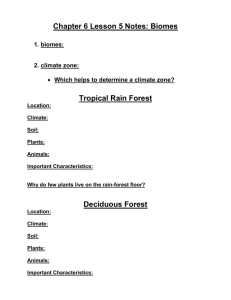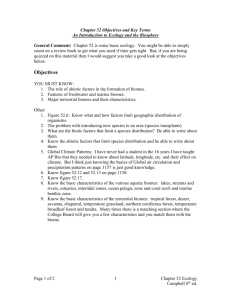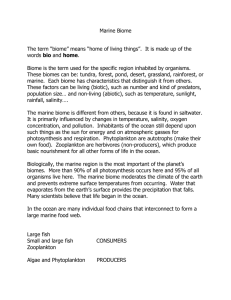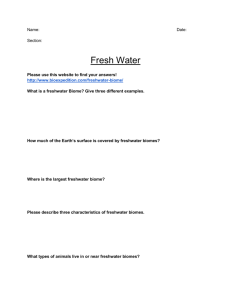General Ecology Info to read
advertisement
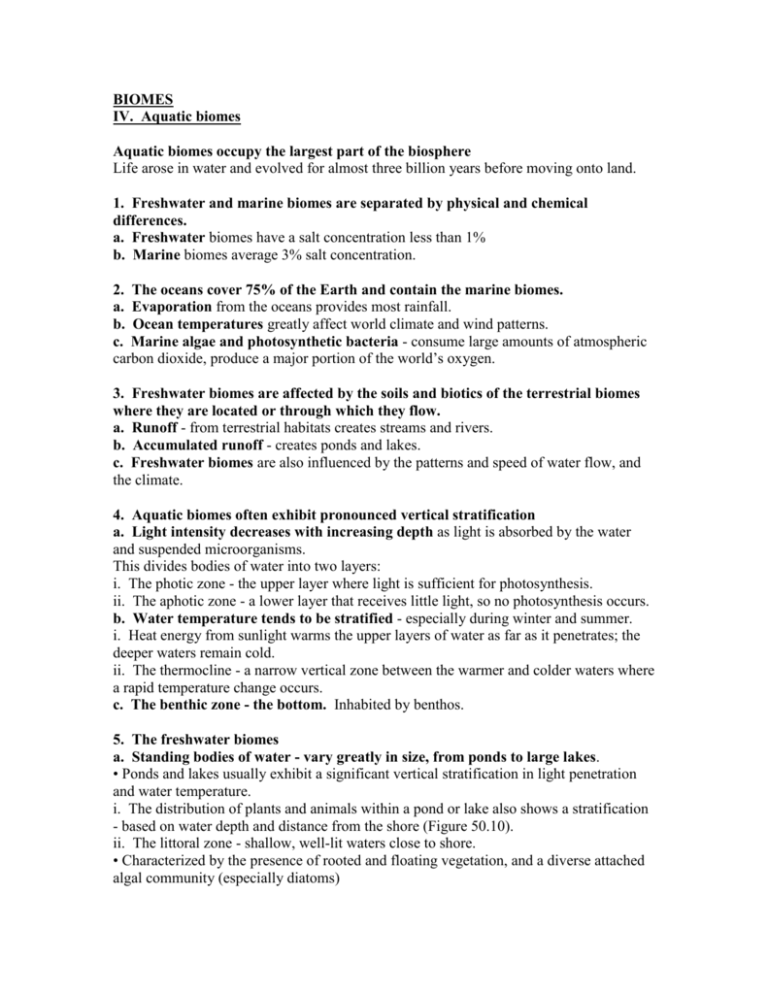
BIOMES IV. Aquatic biomes Aquatic biomes occupy the largest part of the biosphere Life arose in water and evolved for almost three billion years before moving onto land. 1. Freshwater and marine biomes are separated by physical and chemical differences. a. Freshwater biomes have a salt concentration less than 1% b. Marine biomes average 3% salt concentration. 2. The oceans cover 75% of the Earth and contain the marine biomes. a. Evaporation from the oceans provides most rainfall. b. Ocean temperatures greatly affect world climate and wind patterns. c. Marine algae and photosynthetic bacteria - consume large amounts of atmospheric carbon dioxide, produce a major portion of the world’s oxygen. 3. Freshwater biomes are affected by the soils and biotics of the terrestrial biomes where they are located or through which they flow. a. Runoff - from terrestrial habitats creates streams and rivers. b. Accumulated runoff - creates ponds and lakes. c. Freshwater biomes are also influenced by the patterns and speed of water flow, and the climate. 4. Aquatic biomes often exhibit pronounced vertical stratification a. Light intensity decreases with increasing depth as light is absorbed by the water and suspended microorganisms. This divides bodies of water into two layers: i. The photic zone - the upper layer where light is sufficient for photosynthesis. ii. The aphotic zone - a lower layer that receives little light, so no photosynthesis occurs. b. Water temperature tends to be stratified - especially during winter and summer. i. Heat energy from sunlight warms the upper layers of water as far as it penetrates; the deeper waters remain cold. ii. The thermocline - a narrow vertical zone between the warmer and colder waters where a rapid temperature change occurs. c. The benthic zone - the bottom. Inhabited by benthos. 5. The freshwater biomes a. Standing bodies of water - vary greatly in size, from ponds to large lakes. • Ponds and lakes usually exhibit a significant vertical stratification in light penetration and water temperature. i. The distribution of plants and animals within a pond or lake also shows a stratification - based on water depth and distance from the shore (Figure 50.10). ii. The littoral zone - shallow, well-lit waters close to shore. • Characterized by the presence of rooted and floating vegetation, and a diverse attached algal community (especially diatoms) • There is a diverse animal fauna including suspension feeders (clams); herbivorous grazers (snails); and herbivorous and carnivorous insects, crustaceans, fishes, and amphibians. • Animals that frequent this zone can include: reptiles, water fowl, and mammals. iii. The limnetic zone - open, well-lit water away from shore. • Occupants include: photosynthetic phytoplankton (algae and cyanobacteria), zooplankton (rotifers and small crustaceans) that graze on phytoplankton, and small fish which feed on the zooplankton. • Occasional visitors to this zone: large fish, turtles, snakes, and piscivorous birds. iv. The profundal zone - deep, aphotic zone lying beneath the limnetic zone. • This is an area of decomposition where detritus (dead organic matter that drifts in from above) is broken down. • Water temperature is usually cold and oxygen is low due to cellular respiration of decomposers. • Mineral nutrients are usually plentiful due to decomposition of detritus. b. Streams and rivers move continuously in one direction. i. There is a change in structure of these bodies of water from the headwaters to the mouth. ii. At the headwaters - the water is cold and clear, carries little sediment, and has few mineral nutrients. • The channel is narrow with a rocky substrate and the water flows swiftly. iii. Near the mouth - water moves slowly and is more turbid due to sediment entering from other streams and erosion; the nutrient content is higher. • The channel is usually wider with a silty substrate that has resulted from deposition. 6. Wetlands a. Wetland - an area covered by water and supporting aquatic vegetation (Figure 50.17). i. Includes a broad range of habitats from periodically flooded regions to soil that is permanently saturated during growing season. ii. Conditions favor hydrophytes - which are plants specially adapted to grow in water or soil that is periodically anaerobic due to being saturated with water. • Cattails, pond lilies, and sedges are examples of hydrophytes. iii. Both hydrology and vegetation are important determinants in wetland classification. b. The many types of wetlands form in only three topographic situations: i. Basin wetlands - develop in shallow basins ranging from upland depressions to lakes and ponds that have filled in. ii. Riverine wetlands - develop along shallow and periodically flooded banks of streams and rivers. iii. Fringe wetlands - are found along coasts of large lakes and seas where rising lake levels or tides cause water to flow back and forth. • Fringe wetlands include both freshwater and marine habitats. • Marine coastal wetlands are closely linked to estuaries. c. Wetlands are among the richest and most valuable of biomes. i. A diverse invertebrate community is present which supports a wide variety of birds. ii. A variety of herbivores consume the algae, detritus, and plants. iii. They provide water storage basins: reduce the intensity of flooding. iv. They improve water quality by filtering pollutants. Many wetlands have been destroyed for agriculture and development, but a movement to protect the remaining wetlands is underway. 7. Estuaries a. An estuary is the area where a freshwater source merges with saltwater. i. They are often bordered by salt marshes or intertidal mudflats ii. Their salinity varies spatially within the estuary from nearly fresh water to ocean water; varies daily in these areas due to rise and fall of tides iii. Estuaries are very productive due to nutrients brought in by rivers. b. There is a diversity of flora and fauna due to high estuarine productivity. i. Major producers: Salt marsh grasses, algae, and phytoplankton ii. Many species of annelids, oysters, crabs, and fish are also present. iii. Many marine invertebrates and fish breed in estuaries or migrate through them to freshwater habitats upstream. iv. A large number of water fowl and other semiaquatic vertebrates use estuaries as feeding areas. c. Human activities have a huge impact on estuaries. i. Estuaries receive pollutants dumped into streams and rivers that feed them. ii. Residential and commercial development adds to pollution and eliminates some estuaries due to land filling. Very little undisturbed estuary habitat remains. 8. Zonation in marine communities Similar to freshwater communities, marine communities exhibit zonation in depth, distance from shore, degree of light penetration, and open water versus bottom (Figure 50.16b). a. Photic zone - occupied by phytoplankton, zooplankton, and many fish species. b. Aphotic zone - represents a majority of the ocean's volume. c. Intertidal zone - the shallow zone where land meets the ocean. d. Neritic zone - extends from the intertidal zone, across the shallow regions, to the edge of the continental shelf. e. Oceanic zone - extends over deep water from one continental shelf to another; reaches great depth. f. Pelagic zone - refers to open waters of any depth. g. Benthic zone - refers to the seafloor. 9. Intertidal zones – area between high and low tides a. Intertidal zones - alternately submerged and exposed by daily tides. i. Organisms in this zone are exposed to variations in temperature and availability of sea water. ii. These organisms are also subjected to the mechanical forces of wave action. b. Rocky intertidal zones - are vertically stratified and inhabited by organisms that possess structural adaptations that allow them to remain attached in this harsh environment (Figure 50.17). c. Soft sediment intertidal zones - have many burrowing organisms. 10. The oceanic pelagic biome - open ocean waters far from shore. a. Constantly mixed by circulating ocean currents. b. Nutrient content is generally lower than in coastal areas because the remains of organisms sink out of the zone to the lower benthic regions. c. Plankton is prevalent in this zone. i. Photosynthetic phytoplankton - grow and reproduce in the photic region (top 100m) of this biome. ii. Zooplankton (which graze on the phytoplankton) - includes protozoans, copepods, krill, jellies, and larvae of many invertebrates and fishes. d. Nekton (free-swimming animals) - are also found in the oceanic pelagic biome. Large squid, fishes, sea turtles, and marine mammals feed in this area. 11. Benthos - those organisms that inhabit the benthic zone, the ocean bottom. a. The benthic zone receives nutrients in the form of detritus, which settles into the area from the waters above. b. Light and temperature decline rapidly from shallow areas to the ocean's depths. c. Benthic zone substrate - may be sand or very fine sediment composed of silt and shells of dead microscopic organisms. V. Terrestrial biomes A. Tropical forests: found near the equator Temperatures are warm, and days are uniformly 11–12 hours long year-round in the tropical forest. Rainfall is variable and defines subtypes of this biome. There are various types of forests here. The most well known is the rainforest. There is rainfall year-round in this biome. It is characterized by tall trees and a complex 3-D structure. There are many tree dwelling animals. B. Savannas: grasslands with scattered trees Savannas cover wide areas of the tropics in South America, central and South Africa, and temperate North America. They are maintained by frequent fires that keep the trees out, and by large grazing animals and their predators. These include savanna life in Africa (e.g., giraffes, zebras, antelope, baboons, lions, and cheetahs) and Australia (e.g., kangaroos). Savanna habitat in North America is home to bison, deer, black bear, coyotes, and wolves. During the seasonal drought, large mammals must migrate to find suitable grazing and water. C. Deserts: defined by dryness Deserts are centered at about 30° north and south latitudes in regions of descending, dry air masses. Cycles of growth and reproduction are keyed to rainfall. Desert plants are adapted to conserve water and to produce great numbers of seeds that may remain dormant for several years before rain triggers germination. Desert animals are adapted to drought and temperature extremes. Many are burrowers and seed-eaters (e.g., ants, birds, and rodents). Lizards, snakes, and hawks are important predators. D. Chaparral: dominated by shrubs The climate of the chaparral results from cool, offshore ocean currents that produce mild, rainy winters and long, hot, dry summers. Important regions of chaparral include regions around the Mediterranean, coastal Chile, southwestern Africa, southwestern Australia, California, and northwestern Mexico (all chaparrals are mid-latitude coastal areas).Perennial shrubs and annual plants are adapted to periodic fires and require occasional fires to maintain their overall structure. Characteristic animals include browsers (e.g., deer), fruit-eating birds, and seed-eating rodents. Lizards and snakes are important predators. E. Temperate grasslands: include the North American prairie Temperate grasslands are mostly treeless. This biome is maintained in regions with relatively cold winter temperatures, seasonal drought, fires, and grazing by large mammals. These factors prevent the establishment of woody shrubs and trees. Many grazing mammals (e.g., bison and pronghorn of North America, gazelles and zebras of Africa, and wild horses and sheep of Asia). F. Temperate forests: characterized by deciduous trees Temperate deciduous forests occur between latitudes of 35° and 50° in regions where there is enough precipitation to support trees. Animal life is diverse because of the diverse habitats and includes arthropods, birds, and mammals (e.g., whitetail deer, bobcats, foxes, black bears, and mountain lions). G. Coniferous forests: dominated by a few species of trees The main trees of coniferous forests are cone-bearers (e.g., spruce, pine, fir, and hemlock). Fire is essential to this biome. Without periodic fires, deciduous trees will tend to replace the conifers. The taiga (northern coniferous forest, or boreal forest) - forms a broad band across North America and Eurasia. In more southerly regions, it is located at higher elevation, below alpine areas. There is little or no taiga in the Southern Hemisphere. Harsh winters, short warm summers, and considerable precipitation, often as snow, characterize the region. Snow insulates the thin and acidic soil during the winter. Taiga is usually characterized by a few species of conifer, whose shape and resiliency protect them from heavy snow loads. Animals are adapted to cold winters, often remaining active in tunnels under the snow in winter (e.g., mice). Squirrels and birds feed on conifer seeds. Browsers include deer, moose, elk, snowshoe hares, beavers, and porcupines. Predators include bears, wolves, lynxes, and wolverines. H. Tundra: Long, bitter-cold winters Tundra is found from the northern edge of the taiga to the northern limits of land and encircles the North Pole. Alpine tundras - occur at high elevation, above the treeline and below permanent rock and ice, throughout all climatic regions. Vegetation is dominated by low-growing herbs and shrubs, and lichens and bryophytes. During short but warm summers, vascular plants grow and flower quickly. The arctic tundra is characterized by permafrost - a permanently frozen layer of ground beginning a few meters deep and ranging from several meters to over a kilometer in depth. Animals are adapted to the cold by thick fur, or by migratory behavior. Large herbivores include musk ox and caribou. There are a few predators, such as the arctic fox and the snowy owl.



